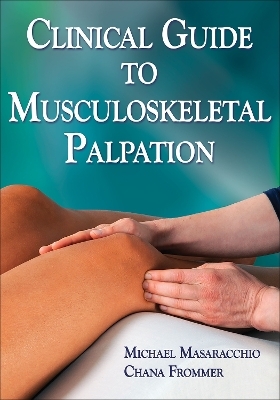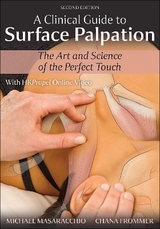
Clinical Guide to Musculoskeletal Palpation
Human Kinetics (Verlag)
978-1-4504-2124-9 (ISBN)
- Titel erscheint in neuer Auflage
- Artikel merken
Musculoskeletal palpation—used in examining the size, consistency, texture, location, and tenderness of anatomical structures—is recognized by medical professionals as a method for detecting and treating a variety of injuries and medical conditions. A comprehensive guide supported by photos that demonstrate palpation techniques of surface body landmarks, Clinical Guide to Musculoskeletal Palpation assists students and health care professionals in becoming proficient in surface palpation techniques, which are a prerequisite for working in the manual therapy professions.
As working professionals and instructors with years of experience using musculoskeletal palpation, Drs. Masaracchio and Frommer are in a unique position to provide a guide that is both clinically oriented and user friendly. For optimal readability and most direct delivery of its content, the text divides the human body into regions instead of joints. Bony and soft tissue structures are covered conjointly instead of independently, allowing for better comprehension of anatomical relationships and ultimately leading to improved clinical examination skills.
Employing a step-by-step approach, Clinical Guide to Musculoskeletal Palpation describes each stage in using palpation as a key component during a physical examination, covering the bony tissue, soft tissue, and neurovascular structures of all body regions. Following are some key features of this text:
• Regional body sections and bulleted text allow for easy reading and enhanced comprehension.
• Techniques are illustrated in a manner unique to clinical practice, which facilitates student learning.
• Each chapter contains pearls of information that promote an appreciation for and acquisition of the inherent feel that is essential for effective palpation.
• Each chapter concludes with a case study presenting a common regional clinical condition, providing readers the opportunity to integrate and apply their new understanding and proficiency.
• The size and format allow the text to be durable and user friendly for clinic and lab activities.
All palpation techniques are presented with easy-to-follow instructions that enable a complete command of the procedure. Anatomical artwork of bony anatomy and soft tissue structures allows for visualization and thus better comprehension of anatomical relationships. This approach fosters a strong foundation that enhances clarity and application of anatomical knowledge to optimize the development of palpation skills. The most comprehensive resource of its kind, Clinical Guide to Musculoskeletal Palpation is a must-have for all practitioners, instructors, and students in the manual therapy professions.
Michael Masaracchio, PT, PhD, OCS, SCS, FAAOMPT, is an associate professor and coordinator of the anatomy lab in the department of physical therapy at Long Island University in Brooklyn. He is board certified in orthopedics and sport physical therapy by the American Physical Therapy Association. A long-time practicing physical therapist, he is currently the senior staff physical therapist at Masefield Cavallaro Physical Therapy, where he specializes in the examination and treatment of orthopedic and sport-related pathologies. In addition to completing his manual therapy fellowship from Regis University, Dr. Masaracchio has been reappointed to the Specialization Academy of Content Experts for the sport physical therapy examination. He has published a randomized clinical trial in the Journal of Orthopaedic and Sports Physical Therapy (March 2013) on the use of thoracic spine thrust manipulation in the management of mechanical neck pain. Dr. Masaracchio has also coauthored two other articles, one on the management of medial collateral ligament injury of the knee in a 13-year-old soccer player (International Journal of Sports Physical Therapy, May 2009) and a review article on the causes and prevention of pediatric and adolescent sports injuries (Orthopaedic Physical Therapy Practice, July 2008). Chana Frommer, PT, DPT, OCS, SCS, RISPT, CCI, is an adjunct associate professor in the department of physical therapy at Long Island University in Brooklyn. She is board certified in orthopedics and sports by the American Physical Therapy Association. A long-time practicing physical therapist, she is currently a clinical director at All Seasons Orthopedics and Sports Physical Therapy, where she specializes in the examination and treatment of orthopedic and sport-related pathologies. Dr. Frommer has recently been reappointed to the Specialization Academy of Content Experts for both the orthopedic and sports physical therapy examinations and is a Registered International Sports Physical Therapist. She is also certified as a clinical instructor (CCI) from the American Physical Therapy Association and serves as an instructor and mentor for physical therapy students during their clinical rotations. Dr. Frommer has been the lead author on a case study that addressed the management of a medial collateral ligament injury of the knee in a 13-year-old soccer player (International Journal of Sports Physical Therapy, May 2009) as well as a review article on the causes and prevention of pediatric and adolescent sports injuries (Orthopaedic Physical Therapy Practice, July 2008).
Chapter 1. Introduction to the Art and Science of Palpation
Definition of Palpation
Goals of Palpation
Psychomotor Skill of Palpation
Importance of Palpation as a Component of the Examination
Role of Anatomy in Palpation
Palpation of Different Structures
Conclusion
Chapter 2. Skull and Face
Functions of the Skull and Face
Bony Anatomy
Soft Tissue Anatomy
Neurovascular Anatomy
Palpation
Chapter 3. Superficial Back and Shoulder Complex
Functions of the Shoulder Girdle Complex
Bony Anatomy
Soft Tissue Anatomy
Neurovascular Anatomy
Palpation
Chapter 4. Pectoral and Axillary Regions
Functions of the Pectoral Region
Bony Anatomy
Soft Tissue Anatomy
Neurovascular Anatomy
Palpation
Chapter 5. Elbow and Forearm
Functions of the Elbow and Forearm
Bony Anatomy
Soft Tissue Anatomy
Neurovascular Anatomy
Palpation
Chapter 6. Wrist and Hand
Functions of the Wrist and Hand
Bony Anatomy
Soft Tissue Anatomy
Neurovascular Anatomy
Palpation
Chapter 7. Cervical and Thoracic Spine
Functions of the Cervical Spine, Thoracic Spine, and Rib Cage
Bony Anatomy
Soft Tissue Anatomy
Neurovascular Anatomy
Palpation
Chapter 8. Lumbar and Sacral Spine
Functions of the Lumbosacral Spine
Bony Anatomy
Soft Tissue Anatomy
Neurovascular Anatomy
Palpation
Chapter 9. Hip and Groin Region
Functions of the Hip Joint
Bony Anatomy
Soft Tissue Anatomy
Neurovascular Anatomy
Palpation
Chapter 10. Knee and Thigh
Functions of the Knee Joint
Bony Anatomy
Soft Tissue Anatomy
Neurovascular Anatomy
Palpation
Chapter 11. Lower Leg, Ankle, and Foot
Functions of the Foot and Ankle Joints
Bony Anatomy
Soft Tissue Anatomy
Neurovascular Anatomy
Palpation
| Erscheint lt. Verlag | 2.6.2014 |
|---|---|
| Verlagsort | Champaign, IL |
| Sprache | englisch |
| Maße | 178 x 254 mm |
| Gewicht | 907 g |
| Themenwelt | Medizin / Pharmazie ► Medizinische Fachgebiete ► Sportmedizin |
| Medizin / Pharmazie ► Physiotherapie / Ergotherapie | |
| Studium ► 1. Studienabschnitt (Vorklinik) ► Physiologie | |
| ISBN-10 | 1-4504-2124-5 / 1450421245 |
| ISBN-13 | 978-1-4504-2124-9 / 9781450421249 |
| Zustand | Neuware |
| Haben Sie eine Frage zum Produkt? |
aus dem Bereich



